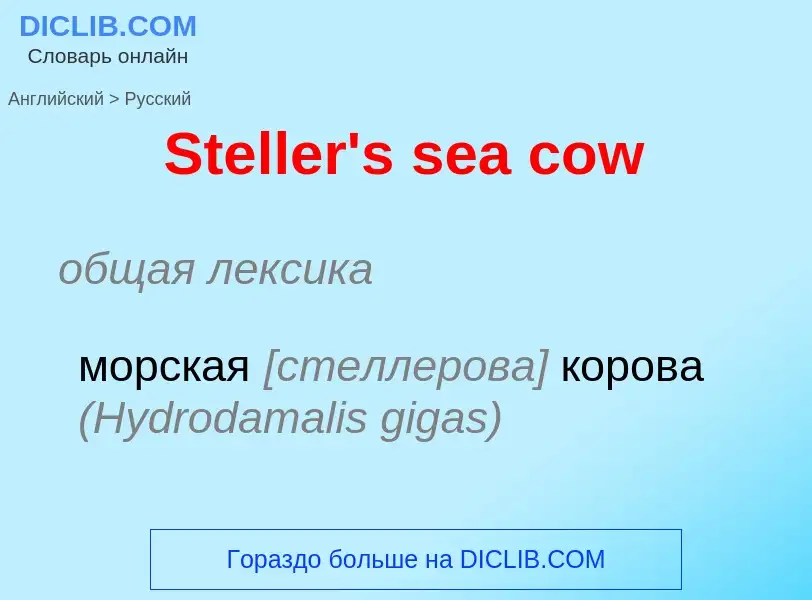Перевод и анализ слов искусственным интеллектом ChatGPT
На этой странице Вы можете получить подробный анализ слова или словосочетания, произведенный с помощью лучшей на сегодняшний день технологии искусственного интеллекта:
- как употребляется слово
- частота употребления
- используется оно чаще в устной или письменной речи
- варианты перевода слова
- примеры употребления (несколько фраз с переводом)
- этимология
Steller's sea cow - перевод на русский
общая лексика
морская [стеллерова] корова (Hydrodamalis gigas)
[ri'tainə]
палеонтология
гидродамал
существительное
палеонтология
гидродамал
общая лексика
белоплечий [тихоокеанский] орлан (Haliaeetus pelagicus)
Смотрите также
['kaupæt]
существительное
эвфемизм
коровья лепёшка (кучка навоза)
общая лексика
белоспинный альбатрос (Diomedea albatrus)
Смотрите также
общая лексика
стеллерова [сибирская] гага (Polysticta stelleri)
['tʃuktʃi(:)'si:]
география
Чукотское море
Определение
2) Эгейское море
Википедия
Steller's sea cow (Hydrodamalis gigas) is an extinct sirenian described by Georg Wilhelm Steller in 1741. At that time, it was found only around the Commander Islands in the Bering Sea between Alaska and Russia; its range extended across the North Pacific during the Pleistocene epoch, and likely contracted to such an extreme degree due to the glacial cycle. It is possible indigenous populations interacted with the animal before Europeans. Steller first encountered it on Vitus Bering's Great Northern Expedition when the crew became shipwrecked on Bering Island. Much of what is known about its behavior comes from Steller's observations on the island, documented in his posthumous publication On the Beasts of the Sea. Within 27 years of its discovery by Europeans, the slow-moving and easily-caught mammal was hunted into extinction for its meat, fat, and hide.
Some 18th-century adults would have reached weights of 8–10 t (8.8–11.0 short tons) and lengths up to 9 m (30 ft). It was a member of the family Dugongidae, of which the 3 m (9.8 ft) long dugong (Dugong dugon) is the sole living member. It had a thicker layer of blubber than other members of the order, an adaptation to the cold waters of its environment. Its tail was forked, like that of whales or dugongs. Lacking true teeth, it had an array of white bristles on its upper lip and two keratinous plates within its mouth for chewing. It fed mainly on kelp, and communicated with sighs and snorting sounds. Steller believed it was a monogamous and social animal living in small family groups and raising its young, similar to modern sirenians.










![[[Alaska pollock]], one of the primary food sources for Steller's sea eagles in their wintering range in Japan [[Alaska pollock]], one of the primary food sources for Steller's sea eagles in their wintering range in Japan](https://commons.wikimedia.org/wiki/Special:FilePath/Alaska Pollock (Gadus chalcogrammus) - GRB.jpg?width=200)
![An immature in [[Łódź Zoo]], Poland. Steller's sea eagles take several years to reach maturity, attaining the adult color pattern when four An immature in [[Łódź Zoo]], Poland. Steller's sea eagles take several years to reach maturity, attaining the adult color pattern when four](https://commons.wikimedia.org/wiki/Special:FilePath/Haliaeetus-pelagicus.jpg?width=200)
![Detail of head of a Steller's sea eagle in the [[Cincinnati Zoo]], United States Detail of head of a Steller's sea eagle in the [[Cincinnati Zoo]], United States](https://commons.wikimedia.org/wiki/Special:FilePath/Steller'sSeaEagle.jpg?width=200)
![Steller's sea eagles near [[Rausu, Hokkaido]], in Japan: catching a fish (up) and carrying a fish (down) Steller's sea eagles near [[Rausu, Hokkaido]], in Japan: catching a fish (up) and carrying a fish (down)](https://commons.wikimedia.org/wiki/Special:FilePath/Steller's Sea Eagle hunting a fish.jpg?width=200)


![Adult in the [[Magadan Nature Reserve]], Russia, a part of the species' breeding range Adult in the [[Magadan Nature Reserve]], Russia, a part of the species' breeding range](https://commons.wikimedia.org/wiki/Special:FilePath/Белоплечий орлан - краснокнижный вид.jpg?width=200)

![Adult bull, females, and pups near [[Juneau, Alaska]], the US Adult bull, females, and pups near [[Juneau, Alaska]], the US](https://commons.wikimedia.org/wiki/Special:FilePath/2008 Juneau Steller Sea Lion Haram (8101629225).jpg?width=200)
![Sea lions haul out on [[Amak Island]] Sea lions haul out on [[Amak Island]]](https://commons.wikimedia.org/wiki/Special:FilePath/Amak Island, Steller's Sea Lion haul out.jpg?width=200)
![Taxidermied specimens, [[Royal British Columbia Museum]] Taxidermied specimens, [[Royal British Columbia Museum]]](https://commons.wikimedia.org/wiki/Special:FilePath/RBCM - Diorama Coastal Cliffs 2.jpg?width=200)
![Sea lion with [[white sturgeon]] Sea lion with [[white sturgeon]]](https://commons.wikimedia.org/wiki/Special:FilePath/Sea lion and Sturgeon.jpg?width=200)
![Near [[Vancouver Island]] Near [[Vancouver Island]]](https://commons.wikimedia.org/wiki/Special:FilePath/Stellers Sea Lions BC.jpg?width=200)


.jpg?width=200)
![Cow dung in [[Bangladesh]] Cow dung in [[Bangladesh]]](https://commons.wikimedia.org/wiki/Special:FilePath/Cow dung fuel.jpg?width=200)





 (13667966664).jpg?width=200)

 (13667593713).jpg?width=200)








![[[Erythraean Sea]] 1838. [[Erythraean Sea]] 1838.](https://commons.wikimedia.org/wiki/Special:FilePath/Soulier, E.; Andriveau-Goujon, J. Anciens Empires Jusqua Alexandre. 1838.jpg?width=200)
![Jansson]] Map of the Indian Ocean ([[Erythraean Sea]]) Jansson]] Map of the Indian Ocean ([[Erythraean Sea]])](https://commons.wikimedia.org/wiki/Special:FilePath/1658 Jansson Map of the Indian Ocean (Erythrean Sea) in Antiquity - Geographicus - ErythraeanSea-jansson-1658.jpg?width=200)

![17th century map depicting the locations of the ''[[Periplus of the Erythraean Sea]]'' 17th century map depicting the locations of the ''[[Periplus of the Erythraean Sea]]''](https://commons.wikimedia.org/wiki/Special:FilePath/PeriplusAncientMap.jpg?width=200)
![A horizontal Malabar Coast miniature, a reprint by [[Petrus Bertius]], 1630 A horizontal Malabar Coast miniature, a reprint by [[Petrus Bertius]], 1630](https://commons.wikimedia.org/wiki/Special:FilePath/A horizontal Malabar Coast miniature, a reprint by Petrus Bertius, 1630.jpg?width=200)
![Asia. [[Sinus Persicus]] and the Mare Persicum Asia. [[Sinus Persicus]] and the Mare Persicum](https://commons.wikimedia.org/wiki/Special:FilePath/Asia in the shape of the mythical winged horse Pegasus..jpg?width=200)
![Iran and [[Makran]] Iran and [[Makran]]](https://commons.wikimedia.org/wiki/Special:FilePath/Map of persia.jpg?width=200)


![Palm]] and [[sunset]] in [[Minoo Island]], Iran. Palm]] and [[sunset]] in [[Minoo Island]], Iran.](https://commons.wikimedia.org/wiki/Special:FilePath/Nakhl-Minoo.jpg?width=200)
![[[Dugong]] mother and her offspring in shallow waters. [[Dugong]] mother and her offspring in shallow waters.](https://commons.wikimedia.org/wiki/Special:FilePath/Dugong.jpg?width=200)





![[[Defense Mapping Agency]] topographical map of the Chukchi Sea, 1973 [[Defense Mapping Agency]] topographical map of the Chukchi Sea, 1973](https://commons.wikimedia.org/wiki/Special:FilePath/Operational Navigation Chart C-8, 2nd edition.jpg?width=200)
